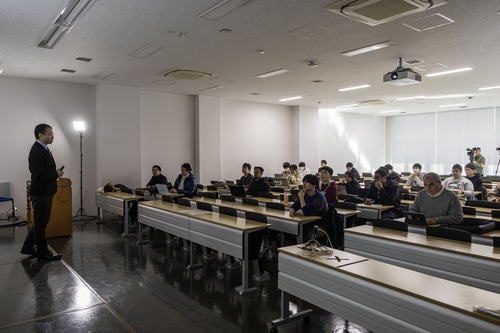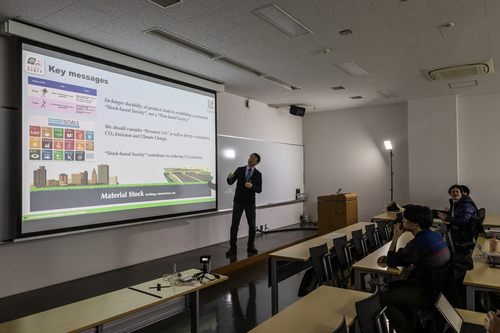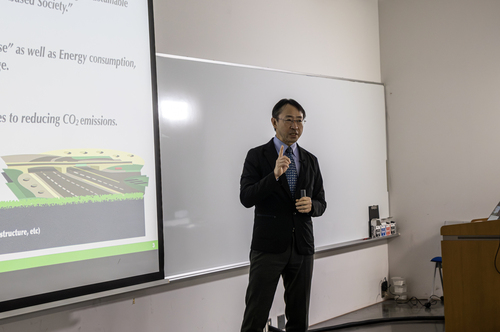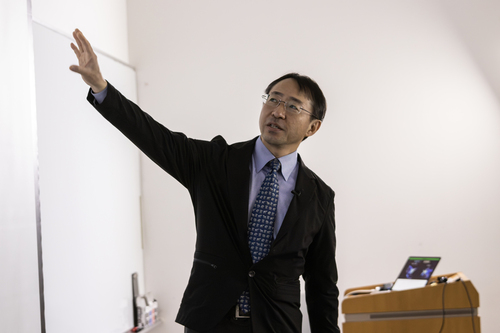Every kilogram of material we use comes with an environmental impact -- Professor Dr. Stefan Bringezu, Universitat Kassel
Introduction
How do you weigh a city? We measure its material stock, of course. On a recent morning at Nagoya University, Professor Hiroki Tanikawa from the Graduate School of Environmental Studies lectured his class on the concept of material stock and its environmental impact. Several Japanese and international students from various programs at Nagoya University, such as G30 and NUPACE, attended his lecture on the Higashiyama Campus in the E&S Building. In this Campus Story, we will use Tanikawa's lecture to introduce the importance of measuring material stock. We hope that it will interest any student thinking about studying environmental engineering at the graduate level in English at a Japanese university.
Accumulating Material Stock
Like a living creature, society must consume material from its environment. Material stock refers to the quantity of construction materials found in buildings, roads, and other types of infrastructure. For example, people use sand and gravel to make concrete, iron ore to make steel, and bitumen to build roads. The amount of raw material extracted worldwide for use as material stock is massive, with 75% going to its creation, maintenance, and operation.
Long-term demand for raw materials and energy drives the accumulation of material stock in both developed and developing countries. Construction of new buildings is essential for housing and business. However, building a single structure also requires enormous volumes of sand, gravel, steel, and water. A building then requires a steady inflow of resources for lighting, heating, and plumbing. In the long term, more materials are required for maintenance, renovation, and, eventually, demolition. Consequently, the construction and maintenance of buildings and infrastructure in industrial societies requires a constant flow of raw materials. However, when discussing resource use and environmental impacts, the essential idea of material stock is often overlooked.
Total Material Requirements and Lifecycle CO2 Emissions
Two important concepts when considering how material stock influences the environment are total material requirements (TMR) and lifecycle CO2. The TMR is the volume of materials necessary for production, consumption, and recycling. By calculating the TMR, we can better understand resource consumption and efficiency. Meanwhile, lifecycle CO2 is the total amount of carbon dioxide emissions associated with a product, process, or activity at all stages of its life. These stages include material acquisition, manufacturing, transportation, and end-of-life processes. Lifecycle CO2 provides an assessment of the environmental impact of a material in terms of greenhouse gas emissions. Therefore, its evaluation is crucial to understand its carbon footprint. Calculating lifecycle CO2 also helps identify opportunities to reduce emissions and promote sustainability.
Total material requirements (TMR) are closely related to lifecycle CO2 emissions because the materials used in the different stages of a product's life cycle contribute to its emissions. The evaluation of TMR allows us to understand the environmental impact of a material by considering energy expenditure and associated CO2 emissions. For example, to produce one ton of steel, the TMR in the excavation of coal and iron ore is 10 tons and lifecycle CO2 emissions are 1.5 to 2 tons. As another example, to produce one ton of Portland cement, the TMR for the excavation of coal, limestone, clay, and silica is 5.8 tons. The process also produces 0.84 tons of lifecycle CO2 emissions.
To further illustrate the importance of calculating the TMR, we can compare the amount needed to produce 1 kg of various materials. For instance, per kilogram, steel requires 10 kg TMR; plastics 10-20 kg TMR; aluminum 50 kg TMR; copper 400 kg TMR; and gold 1,000,000 kg TMR. Professor Yamasue of Ritsumeikan University calls this the "hidden flow of resources". To achieve a more sustainable society, it is essential to reduce the accumulated weight of the material stock.
The Need to Quantify Material Stock
Given the importance of reducing the accumulated weight of the material stock, policymakers must understand its distribution. Since 1998, Professor Tanikawa, along with his laboratory at the Graduate School of Environmental Studies, has conducted research to estimate and evaluate the weight of human activity by measuring the material used in industrial processes. The lab focuses on what is called multiscale material stock analysis. This method quantifies and analyzes the flow of materials within a city, region, or country. This helps academics and policymakers understand the extraction, processing, use, and disposal of materials. As a result, they can more accurately assess resource efficiency, waste generation, and environmental impacts associated with material flows.
Working with his collaborators and students, Tanikawa has conducted multiscale material stock analysis at the national, regional, and city levels. His lab uses four-dimensional geographical information systems (4D-GIS) to analyze material stock above and below ground. In addition to his work in Japan, Tanikawa has conducted extensive research in China to predict demand for steel and cement used in buildings and infrastructure. Multiscale material stock analysis allows for the creation of models and scenarios of material accumulation. Policymakers can then use these results to better understand trends in material stock accumulation and improve future planning.
Material stock and flow analysis can also help us understand the damage caused by earthquakes in urban environments. Following an earthquake, one way to think of debris that needs to be removed is to think of it as material stock. Therefore, by estimating the material stock of a city, policymakers can estimate the amount of material to be removed and the quantity necessary for reconstruction.
Are you interested in studying material stock analysis at Nagoya University?
This campus story is a brief introduction to the concept of material stock and the importance of multiscale material stock analysis. If you are interested in learning about this fascinating topic, the Graduate School of Environmental Studies offers Master's and Ph.D. programs that can be completed in English. We encourage you to look at Professor Tanikawa's website. Please see the relevant links below for further details:
Links:
Professor Tanikawa's lab website
Civil and Environmental Engineering - Global 30 International Programs
By Nagoya University International Communications Office
Photos by Edmund Rhind-Tutt




